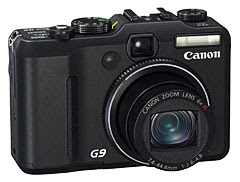 The Canon G9 is my knock-around point-and-shoot camera. It has 12.1MP, a fast lens, does video and actually syncs well above its nominal sync speed of 1/500th of a sec -- if you know how to do it.
The Canon G9 is my knock-around point-and-shoot camera. It has 12.1MP, a fast lens, does video and actually syncs well above its nominal sync speed of 1/500th of a sec -- if you know how to do it.There are a couple ways to pull this off, and the cheapest way is actually the best.
The first thing you have to know if you are going to sync the G9 (or G7) at high speeds is that the camera's onboard flash has to be turned off. Ironic, I know. But the engineers at Canon programmed the flash to sync at 1/500, so when the flash is on that is where your shutter is gonna max out.
So, now that we have turned off the flash, we'll be synching an off-camera flash via the oh-so-handy hot shoe up on top of the camera. The easy way is to use a Pocket Wizard, which works fine but will in practice limit you to a max of about 1/1000th of a second.
This is because of the very minor lag times introduced by the circuitry in the PW itself. This is even more of a hindrance with some of the other wireless remotes, to the point of not being useful at all for some other wireless trigger units.
What you need for really high-speed sync is a simple, dumb wire. This will mean you are limited only by the shutter speed and the power level of the flash.
Why the power level? Because power level (for a speedlight) corresponds to the actual duration of the flash pulse itself. A full-power flash lasts about 1/1000th of a sec. And no matter what synching method you use, you will not squeeze that flash pulse into a 1/2500th of a second's time.
So, first understand that you can expect a full-power manual flash to be fully deployed up to about 1/1000th of a sec. A half-power flash will buy you up to about 1/2000th of a sec. And beyond that, you'll need to limit yourself to a 1/4 power flash, max.
You may think you are synching a full-power flash at 1/2500th, but you are not getting all of it. Just mind the math and you'll be fine.
So, how do we squeeze all of this flash through, without a PW? We use a dumb PC cord. For the camera, you'll need a PC adapter, such as a Nikon AS-15, which converts a hot shoe to a PC cord. Then, you are all set, just as if your camera had a PC jack.
Connect the PC cord to the flash, either by straight connection or via a hot shoe adapter on the other end, and fire away. This will buy you the full synch capability of the G9, but it seems a little cumbersome.
Fortunately, you can bypass all of these steps with a simple, neutered Nikon SC-17 cord. Which is what we will be learning about in the next post.







